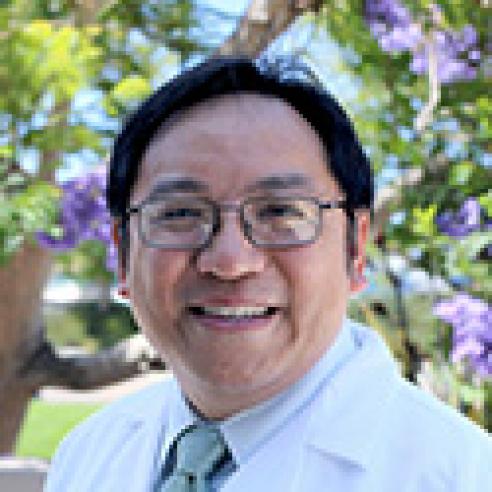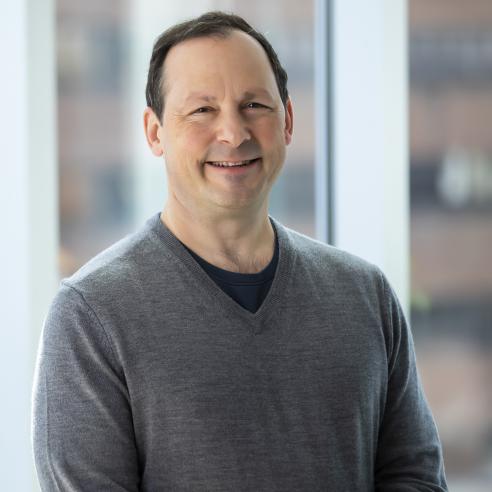They found that even though developing a nuclear cataract is a normal part of aging, if you have a more liquid vitreous it hastens the process. Not only are people who have more vitreous degeneration going to have more problems with nuclear cataracts, a degenerating vitreous can also pull on the retina and cause retinal detachment or macular hole.
A Career Retooled

After this profile was published, Dr. Beebe passed away in 2015 from complications of ALS. His insights into the mechanisms that cause eye diseases continue to be substantiated by his collaborators and other researchers.
"I recently came up with this crazy idea," says David Beebe, PhD, Department of Ophthalmology, Washington University in St. Louis and Editor-in-Chief of Investigative Ophthalmology and Visual Science. "When you turn 35, the best thing we can do for you is stabilize the structure of the vitreous and separate it from the retina. After that, you would be good for the rest of your life."
Maybe not so crazy, the concept comes out of Beebe's findings as a developmental biologist whose clinically-based studies of the vitreous body - the gel that fills the eye - are aimed at identifying the mechanism responsible for age-related nuclear cataracts and open angle glaucoma.
"The way I got into this is quite strange," says Beebe. "Eighteen years ago, before I came to Washington University, my research teammates and I at USUHS, the Defense Department medical school, made a chance observation. We were investigating growth factors in chicken embryo lens development and to our surprise we identified the receptor for vascular endothelial growth factor (VEGF). At that time, it was thought that VEGF receptor was only expressed in blood vessels, where VEGF plays a role in the growth of new capillaries, so finding it in the blood-free lens was weird. Why would it be there?"
The answer to that question led Dr. Beebe on a fruitful path of discovery, paved by RPB.
Moving the bench closer to the bedside
"I had been chairman of a basic science department, but I had arrived at a mid-career point and I was looking for a new trajectory. The RPB Jules and Doris Stein Professorship gave me the opportunity to move into ophthalmology," says Beebe.*
"As a basic scientist moving to a clinical/research department, I needed to learn the language of the clinic. Since I've been here, I've gone to grand rounds every week. Today, I can understand what the issues are. Many of the people training in my lab go to grand rounds to be exposed to clinical problems that they might not have encountered earlier in their education. I may never have taken this approach to research if it were not for the Stein Award."
The lab support portion of the Stein Award made it easier for him to reestablish his lab and to embark on some of his clinical work: "Today, half of my lab is devoted to early eye development. The other half is focused on clinically relevant research - particularly the role played by oxygen in the development of cataracts and glaucoma."
When oxygen goes awry in the eye
"Over time, we learned that VEGF and its receptors increase in expression when you have hypoxia [low oxygen]. We went on to show that the lens makes VEGF all the time. That gave me the idea that, maybe, the lens requires a low oxygen environment for optimum health."
Beebe was aware of other studies indicating that oxygen could be toxic to the lens. In many studies, patients who'd had a vitrectomy [removal of most of the vitreous in preparation for retina surgery] developed nuclear cataracts with very high probability within two years of the surgery. But no one had explained why. The RPB Stein Professorship supported Beebe's initial work, which helped him apply for and receive an NIH grant to continue his investigations.
"We developed a hypothesis," he continues. "If oxygen comes from the blood vessels that feed the retina, and the lens needs to be in a low oxygen environment, then the vitreous body, which sits between the lens and retina, might be important in moderating lens exposure to oxygen and the development of cataracts.
"About that time, I received the RPB Senior Scientist Award and we used it to obtain eye-bank eyes to look at the state of the vitreous. We measured vitreous degeneration and found that, as we age, the vitreous gel becomes more liquid."
"We are currently working with scientists at Purdue University on a way to restore the structure of the vitreous. They have developed compounds to stabilize cartilage in patients with osteoarthritis and the vitreous body is actually like dilute cartilage."
Tracking oxygen levels across the eye
Next, still using money from the RPB Senior Scientific Investigator Award, "We wanted to know what happens to oxygen levels in the eye after removal of the vitreous by vitrectomy" says Beebe. "In collaboration with Dr. Nancy Holekamp, a vitreoretinal surgeon, we used a fiber optic device to measure oxygen in the eyes of patients and, sure enough, exposure of the lens to oxygen increased after vitrectomy."
The Beebe lab has also found that the micronutrient content of the vitreous largely determines its ability to absorb oxygen and plays a role in protecting the lens from oxygen exposure.
"The dietary side of cataract development is very important," says Beebe. "There have been many studies showing that having a better diet protects against cataracts. In our lab, we have shown that vitamin C in the vitreous reacts with oxygen. We also discovered that as the vitreous liquefies, it contains less C.
"Humans don't make C. We get it from our diet. If you have low C in your blood, you have low C in your eye. If you eat lots of fruit and vegetables, you have higher C in your eye. Cataract is largely about lifelong dietary habits."
A healthy vitreous, it turns out, acts as an oxygen sponge. As it degenerates and loses its oxygen-absorbing capacity, or if it is removed via surgery, surrounding tissues in the eye are exposed to higher oxygen.
The oxygen conundrum
"The vitreous separates two domains, the oxygen-rich retina and the oxygen-poor lens," explains Beebe. "An intact, healthy vitreous is going to keep the lens hypoxic, but it may also contribute to retinal hypoxia. This can actually be problematic once we hit 40 or 45, because age-related degenerations can start in our retina, such as wet AMD or diabetic retinopathy. Under those conditions, the vitreous is potentially harmful because it maintains a low oxygen environment and these conditions are promoted by low oxygen.
"This is what led me to my crazy idea. At a certain point, maybe the best thing that can happen is to have your vitreous separate from the retina with the anterior vitreous remaining intact to protect the lens. In fact, if you have posterior vitreous detachment, you're protected against the wet form of AMD. And our research indicates that you're probably going to be protected against diabetic macular edema and diabetic retinopathy, too."
Another oxygen complication: glaucoma?
"Recently, we've taken our clinical investigations a step further - again, quite by surprise. Dr. Stanley Chang [one of the country's leading retina surgeons and former department Chair] at Columbia noted that if you have a vitrectomy and then cataract surgery, you have a much higher risk of open-angle glaucoma. Based on our studies, he suggested that the lens is protecting the anterior segment against oxygen damage, right where the initial damage is done in glaucoma. Together with Dr. Carla Siegfried, we recently provided evidence for Stanley's idea. Being an observant clinician is incredibly important for medical research. It's why I have such close collaborations with clinicians.
"RPB support has been a game changer for me, both the continuity of funding and the lack of restrictions on the direction of your studies, which lets you turn surprises into sound scientific sense."
*The Jules and Doris Stein RPB Professorship encourages established, basic scientists to bring their expertise into a department of ophthalmology. It provides additional funds for lab support. In 2014, the Stein Professorship will be folded into the new Stein Innovation Award.
March 29, 2016
Related News: Cataract, Glaucoma

Research to Prevent Blindness and Alcon Award Glaucoma Grant
Dr. Alex Huang of the University of California San Diego School of Medicine will study glaucoma filtration surgeries with the aim of improving surgical success for lowering eye pressure and providing neuroprotection.

Research to Prevent Blindness Marks $400 Million in Funding to Advance Eye Disease Research
RPB funds a new round of researchers and hits a milestone in supporting vision-related breakthroughs.

RPB and Association of University Professors of Ophthalmology Announce 2023 Recipient of RPB David F. Weeks Award for Outstanding Vision Research
David J. Calkins, PhD, is recognized for ground-breaking contributions to the field of vision research.

New Glaucoma Research Grant Available
Research to Prevent Blindness and Aerie Pharmaceuticals are partnering to provide grant opportunities to support novel research in glaucoma.

Research to Prevent Blindness and Association of University Professors of Ophthalmology Announce 2022 Recipient of RPB David F. Weeks Award for Outstanding Vision Research
Donald Zack, MD, PhD, is recognized for ground-breaking contributions to the field of vision research.
Subscribe
Get our email updates filled with the latest news from our researchers about preventing vision loss, treating eye disease and even restoring sight. Unsubscribe at any time. Under our privacy policy, we'll never share your contact information with a third party.
| General Info | Grants | News & Resources |




